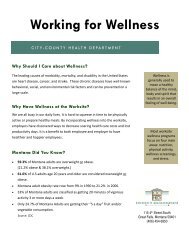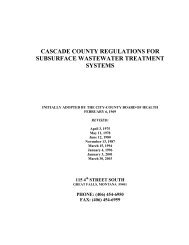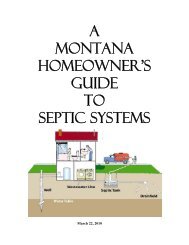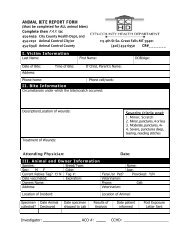Historic Dates and Events Related to Vaccines and Immunization
Historic Dates and Events Related to Vaccines and Immunization
Historic Dates and Events Related to Vaccines and Immunization
Create successful ePaper yourself
Turn your PDF publications into a flip-book with our unique Google optimized e-Paper software.
<strong>His<strong>to</strong>ric</strong> <strong>Dates</strong> <strong>and</strong> <strong>Events</strong> <strong>Related</strong> <strong>to</strong> <strong>Vaccines</strong> <strong>and</strong> <strong>Immunization</strong><br />
<strong>Immunization</strong> <strong>and</strong> the former Programme for Vaccine Development, <strong>and</strong> adding a new unit for Vaccine Supply <strong>and</strong> Quality.<br />
1994 The entire Western Hemisphere was certified as "polio-free" by the International Commission for the Certification of Polio Eradication,<br />
WHO.<br />
1993 The Institute of Medicine published "The Children's Vaccine Initiative: Achieving the Vision." Later, following the events of September<br />
11, 2001, the Institute of Medicine again called for creation of a national vaccine authority ""<strong>to</strong> advance the development, production,<br />
<strong>and</strong> procurement of new <strong>and</strong> improved vaccines of limited commercial potential but of global public health need.""<br />
1993 The National <strong>Immunization</strong> Program (NIP) was created as a separate program reporting directly <strong>to</strong> the Office of the Direc<strong>to</strong>r at CDC.<br />
NIP was established <strong>to</strong> provide federal leadership <strong>and</strong> services <strong>to</strong> all local <strong>and</strong> state public health departments involved in immunization<br />
activities (e.g., disease surveillance for vaccine-preventable diseases, development of vaccine information management systems).<br />
May 1, 1993 The costs of influenza vaccine <strong>and</strong> its administration became a covered benefit under Medicare Part B.<br />
March 1993<br />
March 1993<br />
Conjugated Haemophilus influenzae type b vaccines (ActHIB by Connaught/Mérieux <strong>and</strong> OmniHib by SmithKline Beecham) were<br />
licensed.<br />
A combined Haemophilus influenzae type b vaccine <strong>and</strong> whole cell DTP vaccine (Tetramune by Lederle/Praxis) was licensed.<br />
1993 The development of immunization registries was promoted at the national level. A national health goal for 2010 was subsequently<br />
established <strong>to</strong> increase the participation in population-based immunization registries <strong>to</strong> 95%.<br />
1993 The <strong>Vaccines</strong> for Children Program was established after passage of the Omnibus Budget Reconciliation Act of 1993. Federallypurchased<br />
vaccines under this program were made available <strong>to</strong> children from birth through 18 years of age who met one of the following<br />
requirements: Medicaid-enrolled, without health insurance, <strong>and</strong> American Indian or Alaskan native. Also, children with health insurance<br />
that did not cover the costs of immunization were eligible <strong>to</strong> receive vaccines at a federally-qualified health center or a rural health<br />
clinic. All ACIP recommended vaccines received funding, which included new vaccines, new vaccine combinations, <strong>and</strong> revised<br />
recommendations for vaccine use.<br />
Dec 10, 1992<br />
Sept 20, 1992<br />
Dec 17, 1991<br />
Nov 22, 1991<br />
August 1991<br />
Jan 11, 1991<br />
Dec 21, 1990<br />
April 13, 1990<br />
Dec 20, 1989<br />
Dec 15, 1989<br />
Aug 28, 1989<br />
Japanese encephalitis (JE) virus vaccine inactivated (JE-Vax by Research Foundation for Microbial Diseases of Osaka University<br />
[BIKEN]) was licensed. JE is the leading cause of viral encephalitis in Asia. WHO acts as a facilita<strong>to</strong>r for the development of new JE<br />
vaccines that are safer, require fewer doses, <strong>and</strong> are more suitable for public health use, in particular, in disease-endemic developing<br />
countries.<br />
Diphtheria <strong>and</strong> tetanus <strong>to</strong>xoids <strong>and</strong> acellular pertussis vaccine (Tripedia by Connaught) was licensed for use as the fourth <strong>and</strong> fifth<br />
doses in the series.<br />
Diphtheria <strong>and</strong> tetanus <strong>to</strong>xoids <strong>and</strong> acellular pertussis vaccine (Acel-Imune by Lederle) was licensed for use as the fourth <strong>and</strong> fifth<br />
doses in the series.<br />
ACIP recommendations for routine hepatitis B vaccination for all infants were published in MMWR.<br />
The last case of indigenous polio in the Western Hemisphere occurred in a 5-year-old boy, Luis Fermin Tenorio, in Pichanaqui, Peru.<br />
Recommendations of ACIP for routine Hib vaccination for infants beginning at 2 months of age were published in MMWR.<br />
An enhanced-potency inactivated poliovirus vaccine (Ipol by Pasteur Méérieux Vaccins et Serums) was licensed.<br />
ACIP recommendations for use of any of the three licensed Hib conjugate vaccines (ProHIBIT, HibTITER, <strong>and</strong> PedvaxHIB) for children<br />
as young as 15 months of age were published in MMWR.<br />
Conjugated Haemophilus influenzae type b (Hib) vaccine (PedvaxHIB by Merck) was licensed.<br />
A live, oral typhoid vaccine (Ty21a, Vivotif Berna by Swiss Serum Institute) was licensed.<br />
Recombinant hepatitis B vaccine (Engerix-B by SmithKline Beecham) was licensed.<br />
1989 Recommendations for routine 2nd doses of measles-containing vaccine were issued by both ACIP <strong>and</strong> the AAP. During the mid- <strong>to</strong><br />
late-1980s, a high proportion of reported measles cases were in school-aged children (5-19 years) who had been appropriately<br />
vaccinated. These vaccine failures led <strong>to</strong> national recommendations for a second dose of measles-containing vaccine.<br />
Dec 21, 1988<br />
Conjugated Haemophilus influenzae type b vaccine (HibTITER by Wyeth-Lederle) was licensed.<br />
1988 The Center for Biologics Evaluation <strong>and</strong> Research (CBER) was created within the FDA <strong>to</strong> regulate biological products, including blood,<br />
vaccines, tissue, allergenics, <strong>and</strong> biological therapeutics.<br />
1988 The World Health Assembly (the ministers of health of all member states of the WHO) passed a resolution <strong>to</strong> eradicate polio by the year<br />
2000.<br />
1988 The National Vaccine Injury Compensation Program (NVICP) was established <strong>to</strong> provide compensation following a vaccine-related<br />
adverse event that resulted in injury or death. NVICP was intended <strong>to</strong> serve as an alternative <strong>to</strong> civil litigation. The law established a<br />
Vaccine Injury Table that provided a list of compensable vaccination events <strong>and</strong>, for each, an associated time period requirement.<br />
Jan 22, 1988<br />
ACIP recommendations <strong>to</strong> administer Hib conjugate vaccine <strong>to</strong> all children at 18 months of age were published in MMWR.<br />
http://www.immunize.org/timeline/[6/20/2013 5:22:19 PM]








